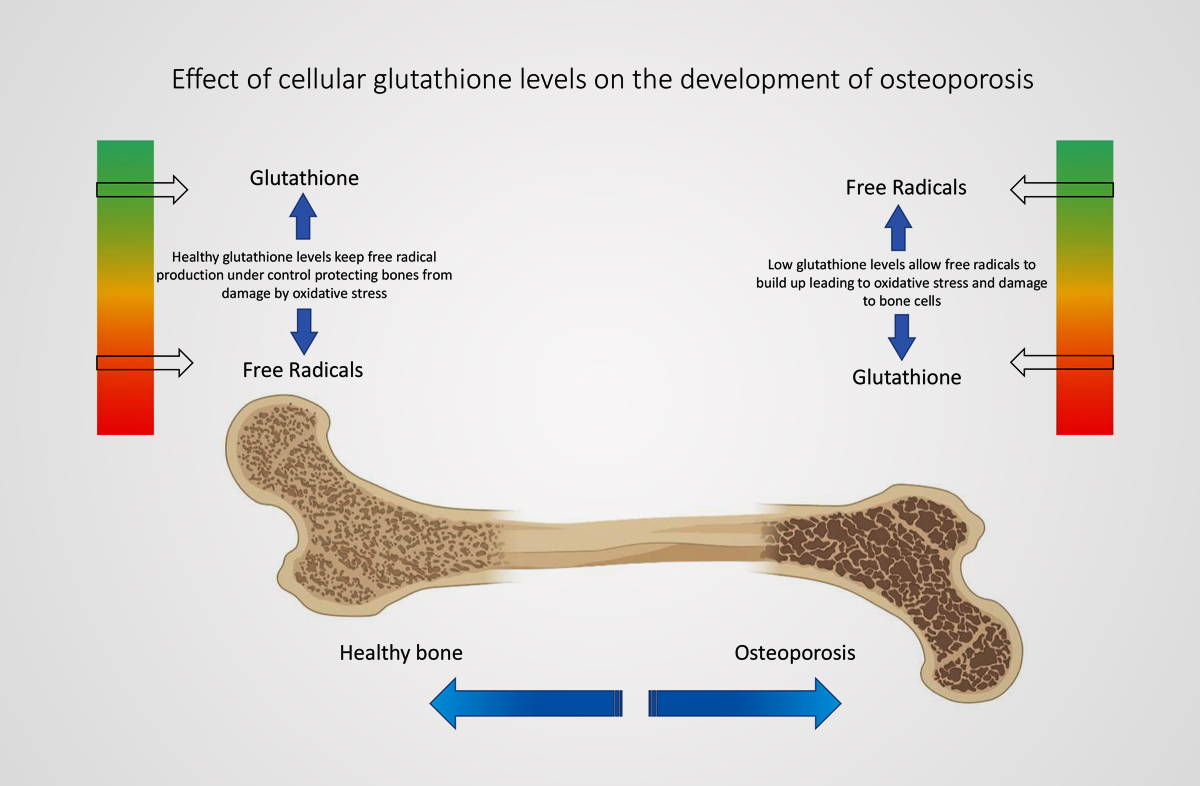Author: Emma Beukers
Osteoporosis is a debilitating skeletal condition characterized by low bone density, causing bone fragility and increased risk of bone fractures [1]. The body constantly renews bone tissue by absorbing old tissue and regenerating new tissue. As we get older, these two processes become unbalanced, resulting in increased bone resorption and decreased bone formation [2]. This is a contributing factor for the gradual loss in bone density and strength as we age. Other factors impacting bone health may include cellular changes, genetic damage due to complex age-related changes as well as nutritional deficiencies of calcium and vitamin D. Oxidative stress can also negatively affect bone health [2].
Oxidative stress occurs due to excessive reactive oxygen species (ROS) paired with inadequate levels of antioxidants, in particular glutathione [3]. The level of ROS in the body increases with age and as a result of negative lifestyle factors such as smoking [4] and obesity [5]. This progressively weakens the maintenance of functional tissues [6] and further negatively impacts the balance of bone formation and bone resorption [7-8].
The body has a finely tuned antioxidant system which neutralizes ROS. This includes the group of antioxidant vitamins such as C & E, but in particular glutathione, which is the most powerful antioxidant in its own right. Glutathione also recycles Vitamins C & E and is therefore the cornerstone of our complex antioxidant response [9].
The importance of glutathione is well recognized in the medical community [9]. We also know that the body’s production of glutathione slows down as we age and is negatively affected by stress, toxins and illness [10]. Even strenuous exercise can temporarily reduce cellular glutathione below optimal. Strategies to enhance glutathione have been explored, but they have been met with very limited success. Supplements such as n-acetylcysteine (NAC), herbal remedies or even glutathione itself do not have the ability to increase glutathione within our cells and, although popular, fail to achieve their objective. For a supplement to be effective, it also needs to be able to increase cellular glutathione above homeostasis, or the natural set point determined by the enzymatic production of glutathione in our cells. This set point progressively becomes lower as we age resulting in suboptimal glutathione production.
Another contributing factor to bone health is Vitamin D, a deficiency of which has long been associated with weak bone formation. Rickets is a disease of the bone directly caused by low levels of Vitamin D as well as dietary calcium. A deficiency in Vitamin D also hinders the absorption of calcium and promotes the release of calcium from the bones, which can lead to the development of osteoporosis. This can significantly weaken bone strength and flexibility, leading to a reduced ability to withstand stress [11]. Recent studies have shown a strong correlation between glutathione depletion and the bioavailability of both vitamin D and dietary calcium [12-13]. Vitamin D supplements are therefore not successful unless glutathione status is at optimal levels [12]. Additionally, it has been shown that decreased glutathione, and the consequent increase in ROS levels, results in a decline of calcium absorption, hindering the effective mineralization of the skeleton [13].
Hence, it would be beneficial to have increased glutathione levels in order to ensure optimal Vitamin D absorption and minimal oxidative stress. Supplementation with gamma-glutamylcysteine has shown to increase cellular glutathione levels above homeostasis [14] and therefore proves to have potential value as a preventative therapy for osteoporosis by reducing oxidative stress and optimizing Vitamin D and calcium absorption.
References
- Sozen, T.; Ozisik, L.; Calik Basaran, N. An Overview And Management Of Osteoporosis. European Journal of Rheumatology 2017, 4 (1), 46-56.
- Corrado, A.; Cici, D.; Rotondo, C.; Maruotti, N.; Cantatore, F. Molecular Basis Of Bone Aging. International Journal of Molecular Sciences 2020, 21 (10), 3679.
- Zhou X, Wang Z, Ni Y, Yu Y, Wang G, Chen L. Suppression effect of N-acetylcysteine on bone loss in ovariectomized mice. Am J Transl Res. 2020;12(3):731-742.
- Kamceva, G.; Arsova-Sarafinovska, Z.; Ruskovska, T.; Zdravkovska, M.; Kamceva-Panova, L.; Stikova, E. Cigarette Smoking And Oxidative Stress In Patients With Coronary Artery Disease. Open Access Macedonian Journal of Medical Sciences 2016, 4 (4), 636-640.
- Matsuda, M.; Shimomura, I. Increased Oxidative Stress In Obesity: Implications For Metabolic Syndrome, Diabetes, Hypertension, Dyslipidemia, Atherosclerosis, And Cancer. Obesity Research & Clinical Practice 2013, 7 (5), e330-e341.
- Cui, H.; Kong, Y.; Zhang, H. Oxidative Stress, Mitochondrial Dysfunction, And Aging. Journal of Signal Transduction 2012, 2012, 1-13.
- Almeida M, Han L, Martin-Millan M, Plotkin LI, Stewart SA, Roberson PK, Kousteni S, O’Brien CA, Bellido T, Parfitt AM, Weinstein RS, Jilka RL, Manolagas SC. Skeletal involution by age-associated oxidative stress and its acceleration by loss of sex steroids. J Biol Chem. 2007;282:27285–27297.
- Domazetovic V, Marcucci G, Iantomasi T, Brandi ML, Vincenzini MT. Oxidative stress in bone remodeling: role of antioxidants. Clin Cases Miner Bone Metab. 2017;14:209–216.
- Pizzorno, J. Glutathione!. Integrative Medicine: A Clinician’s Journal 2014, 1 (13), 8-12.
- Mosoni, L.; Breuillé, D.; Buffière, C.; Obled, C.; Mirand, P. Age-Related Changes In Glutathione Availability And Skeletal Muscle Carbonyl Content In Healthy Rats. Experimental Gerontology 2004, 39 (2), 203-210.
- Laird, E.; Ward, M.; McSorley, E.; Strain, J.; Wallace, J. Vitamin D And Bone Health; Potential Mechanisms. Nutrients 2010, 2 (7), 693-724.
- Jain, S.K., R. Parsanathan, A.E. Achari, P. Kanikarla-Marie, and J.A. Bocchini, Jr., Glutathione Stimulates Vitamin D Regulatory and Glucose-Metabolism Genes, Lowers Oxidative Stress and Inflammation, and Increases 25-Hydroxy-Vitamin D Levels in Blood: A Novel Approach to Treat 25-Hydroxyvitamin D Deficiency. Antioxid Redox Signal, 2018. 29(17): p. 1792-1807
- Moine, L., M. Rivoira, G. Díaz de Barboza, A. Pérez, and N. Tolosa de Talamoni, Glutathione depleting drugs, antioxidants and intestinal calcium absorption. World J Gastroenterol, 2018. 24(44): p. 4979-4988.
- Zarka, M.H. and W.J. Bridge, Oral administration of γ-glutamylcysteine increases intracellular glutathione levels above homeostasis in a randomized human trial pilot study. Redox Biology, 2017. 11: p. 631-636.

